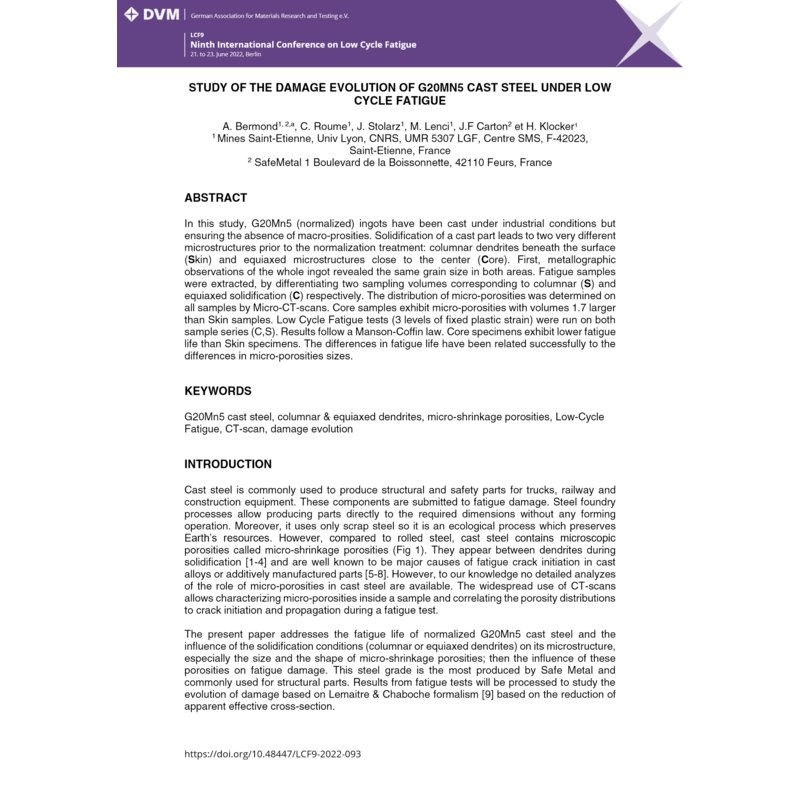- Nur online erhältlich



The damage evolution in low cycle fatigue of a cast steel is a complex phenomenon where many microstructural parameters take action during cracks initiation & growth. In fact, the steel foundry process generates typical populations of non-metallic inclusions and porosities, which are inherent in the process [1] [2]. Moreover, the specific solidification of a cast part (Figure 1a) leads to two very different microstructures: columnar dendrites under the surface of the part that become equiaxed while going toward the center. Porosities of solidification as known as micro-shrinkages (Figure 1b) form in inter-dendritic areas [3] when remaining liquid steel can’t compensate the shrinkage from solid steel. Those porosities will have different size and shape depending on their forming…

Datenschutzbedingungen (bearbeiten im Modul "Kundenvorteile")

Lieferbedingungen (bearbeiten im Modul "Kundenvorteile")

Rücksendebedingungen (bearbeiten im Modul "Kundenvorteile")
The damage evolution in low cycle fatigue of a cast steel is a complex phenomenon where many microstructural parameters take action during cracks initiation & growth. In fact, the steel foundry process generates typical populations of non-metallic inclusions and porosities, which are inherent in the process [1] [2]. Moreover, the specific solidification of a cast part (Figure 1a) leads to two very different microstructures: columnar dendrites under the surface of the part that become equiaxed while going toward the center. Porosities of solidification as known as micro-shrinkages (Figure 1b) form in inter-dendritic areas [3] when remaining liquid steel can’t compensate the shrinkage from solid steel. Those porosities will have different size and shape depending on their forming area.
Recent works have demonstrated that micro-shrinkages play a key role into fatigue damage mechanisms in a cast steel [4] [5]. However, it is difficult to know precisely which parameters are critical: the size of the porosity, its shape, orientation, position and so on. Current studies use CT-scan to detect and quantify present porosities in fatigue specimens, and also to track crack initiation & growth during in-situ tests [6] [7]. This experimental approach is very interesting because it allows characterizing the porosities population and study its impact in fatigue damage. Unfortunately, steel is quite dense; those researches are applied to lighter alloys (titanium or aluminum based). Nevertheless, we find in literature applications for tracking voids growth during a tensile test [8].
In this study, G20Mn5 (normalized) ingots have been cast and fatigue sample were extracted from them, by separating two sampling areas: skin and core. The first one correspond to columnar solidification and the second one to equiaxed solidification. Three levels of plastic deformation have been chosen and a least 10 specimen from each area were tested for each level. CT-scans were used to quantify porosities inside some specimens before fatigue tests and after to locate the crack. Meanwhile, a metallographic study has been done to characterize the microstructure in the whole ingot.
Concerning porosities, CT-scans show micro-shrinkages with a bigger volume inside specimens from the core of the ingot, around 1.7 times more than specimens from the skin of the ingot. Moreover, by comparing CT-scans and fracture areas observed with SEM, we were able for some specimens to find the porosity that initiated the crack (Figure 2a & 2b).
Results from low cycle fatigue tests allows us to match a Manson-Coffin law close to a study on G20Mn5QT [4]. It also appears that, under high cyclic plastic deformation, specimens from core ingot have a lower fatigue life. Differences between the two populations of porosities could explain those results. However, based on Chaboche & Lemaitre damage definition with remaining area and effective stress [9], its evolution shows two phases during tests that we can associated to crack initiation and growth (Figure 3). Moreover, damage evolution does not seem to depend on the sampling areas but only on loadings.
Our study shows how important are micro-shrinkages regarding fatigue damage mechanisms and they can be linked to solidification conditions. CT-scans is a usefull tool to characterize porosities inside a sample, but nowadays a common tomograph don’t provide a sufficient resolution in steel to detect properly those small porosities with complex shapes. The study of damage evolution is an original and easy way to model crack initiation and growth. Associated with a strain-life law such as Manson-Coffin, it gives a good estimation of fatigue life and critical damage that leads to crack propagation.
Références
[1] Masson, J.-M. (2007). « Elaboration de l’acier moulé – Analyse des processus métallurgiques »
[2] Riedler, M. et al. (2018). “Formation of shrinkage porosity during solidification of steel: Numerical simulation and experimental validation”, International Symposium on Liquid Metal Processing & Casting 2015.
[3] Dantzig, J. A. & Rappaz, M. (2016). « Solidification (2nd Edition) », EPFL Press
[4] Han, Q. et al. (2016). “Fatigue Behaviour of G20Mn5QT Cast Steel and Butt Welds with Q345B Steel”, International Journal of Steel Structures 16.
[5] Hardin, R. et al. (2002). “Effect of Shrinkage on Service Performance of Steel Castings”, Proceedings of the 56th SFSA Technical and Operating Conference.
[6] Rotella, A. et al. (2017). « Fatigue d’un alliage d’aluminium moulé A357-T6 : rôle de la morphologie, de la position des défauts et application à une structure pour le calcul de la durée de vie en fatigue », ISAE-ENSMA
[7] Serrano-Munoz, I. et al. (2017). « Location, location & size: defects close to surfaces dominate fatigue crack initiation.” Sci. Rep. 7, 45239 (2017).
[8] Seo, D et al. (2015). « In Situ Observation of Void Nucleation and Growth in a Steel using X-ray Tomography », ISIJ International, Vol. 55 (2015), No. 7, pp. 1474-1482
[9] Lemaitre, J & Chaboche, J.L. (1990). « Mechanics of solid materials », Cambridge University Press, Chapter 7